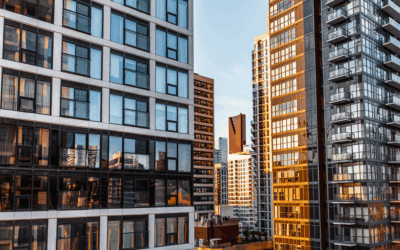Looking for reasons why it’s a good idea to invest in multifamily real estate?
Simply put, it’s hard to go wrong with an asset class that accounted for over a third of all commercial property investment in 2024 (more than any other sector).
Of course, commercial real estate multifamily investments move in cycles like any other sector — activity nearly doubled back in 2021 and climbed close to 120% before the recent cooldown.
Sales prices have since adjusted to end a ten-year streak of steady growth, but this is a recalibration, not a retreat.
CoStar’s index confirms the segment’s robustness: the multifamily market may be correcting, but it’s still one of the most stable and profitable.
Multifamily commercial real estate consistently delivers reliable income, long-term growth potential, and scalable investment opportunities.
Institutional firms and private investors alike are increasing their allocations to apartments across the United States, and it’s easy to see why.
Investing in multifamily apartments strikes a balance between stability and upside. It spreads risk across many tenants, performs well during downturns, and supports various strategies—from steady cash flow to value-add renovations.
In this post, we break down the benefits of multifamily investing if you are planning to make it a part of your CRE portfolio, plus tips on how to proceed if this is your first time.
Top 10 Reasons to Invest in Multifamily Real Estate
1. Stable and predictable cash flow
Multifamily properties tend to generate steady rental income because it spreads risk across multiple units, which means that you are not 100% exposed to any single tenant.
Compared to office or retail buildings that often rely on fewer and longer-term leases, apartments provide more predictable revenue.
Turnover is usually manageable and units can be re-rented quickly in most US markets, so you can maintain a consistent cash flow year-round.
2. Strong long-term demand trends
Population shifts and limited new supply — combined with the rising costs of buying homes — all point toward continued demand for rentals.
US Census and HUD data show that completions have begun to outpace new starts, meaning the pipeline for future inventory is shrinking.
At the same time, more Americans are delaying homeownership. This further reinforces the need for quality rental housing in urban and suburban areas.
3. Recession‑resilient performance
Multifamily buildings — especially middle-market apartments —tend to outperform other asset types during economic downturns.
In the 2008 recession, CBRE data showed that Class B apartment rents fell only about 9.1% — that might seem sizeable, but it’s a much smaller drop compared to Class A and Class C properties.
Middle-market rentals often attract tenants who are downsizing or looking for more affordable options. This helps keep occupancy up and reduces volatility when the broader economy slows down.
4. Tax advantages
There are several tax advantages to investing in multifamily apartments. For example, you can deduct depreciation and mortgage interest, both of which help reduce taxable income.
You can also choose to defer capital gains taxes when selling and reinvesting in another property through a 1031 exchange.
Many multifamily commercial real estate investors use LLCs or partnerships to pass these benefits directly to individuals, making this segment a tax-efficient choice.
5. Scalability of investment
Investing in multifamily properties lets you grow your portfolio without adding excessive complexity.
You can begin with a small property (like a duplex or fourplex) and move up to larger commercial buildings with dozens or even hundreds of units.
Unlike single-family rentals that require separate loans and management setups, multifamily buildings allow you to expand using just one loan and one management system. This is why they are more scalable than other residential investments.
6. Ability to force appreciation
What’s more, multifamily real estate gives you direct control over how much value you create — something that you can’t say about stocks or bonds.
You can upgrade units and improve amenities and/or tighten operations to raise your NOI. And because NOI and cap rates drive multifamily property values, those changes will let you sell the building for much more than you bought it.
Even a modest rent increase across dozens or hundreds of units can boost your asset’s value substantially — often outperforming general market appreciation.
Read our tips on how to improve your multifamily property.
7. Easier financing than other CRE types
There are more financing options for multifamily than for most commercial real estate types.
Depending on the size of your project, you can potentially access loans through Fannie Mae and Freddie Mac with longer amortization periods and lower interest rates.
For bigger buildings, you can also borrow from private lenders if you have a solid multifamily investment strategy. Lenders generally see apartments as lower risk compared to sectors like office or hospitality.
8. Portfolio diversification
Multifamily can add a stabilizing layer to your CRE portfolio, especially if it leans too heavily on retail, office, and industrial, which may see revenue swings tied to consumer trends and supply chains.
Apartment demand tends to stay more consistent. Renter households don’t move based on GDP fluctuations — they need housing regardless of market conditions.
9. Hedge against inflation
Most leases are short-term (typically one year) so you can raise rents annually in response to inflation to preserve and even grow your real return.
WSJ reporting shows that apartment vacancy is near historic lows and rental demand is the highest it’s been since 1985 — that means strong pricing power for owners who can meet the demand.
10. Strong exit opportunities and liquidity
Multifamily continues to attract serious capital in 2025 as large institutional buyers —including REITs, private equity firms, and family offices — actively compete for assets. Equity Residential purchased over 3,500+ units for $964 million.
Morgan Properties acquired 3,000+ units in the Midwest for $501 million. In San Francisco alone, Q1 2025 saw $363 million in multifamily transactions — three times more than the year before.
The result is a liquid and highly competitive market with strong exit potential. Whether you’re planning a short hold or long-term strategy, this depth of buyer interest gives you options.
Tips for First-Time Multifamily Investors
Will this be your first time investing in multifamily apartments? The learning curve can feel steep — but don’t worry because the potential rewards are worth it. Here’s how to prepare:
- Study local demand and not just the national headlines.
Market fundamentals really start at the zip code level. National or state-level averages won’t tell you how a specific submarket is performing.
You need to use tools like CoStar, Reonomy, and your local economic development agency to dig deeper.
Look for submarkets with declining vacancy rates and healthy rent growth, as well as areas with diverse employment bases.
Review how many units have been absorbed in the past year and check whether new construction is slowing or accelerating. Read between the lines.
A tech-heavy neighborhood might look attractive, but there could be downward pressure on rents and occupancy if completions are outpacing job growth.
- Target areas with job growth and population inflows.
Job and population growth drive rental demand. Focus on metro areas with sustained hiring activity across multiple sectors — healthcare, logistics, education, and tech, for example. Use Bureau of Labor Statistics data to pinpoint stable employment hubs.
It’s also a good idea to review US Census migration trends. Markets with steady in-migration especially among younger renters often support long-term multifamily performance.
Sun Belt cities and fast-growing secondary metros continue to draw renters seeking affordability and quality of life.
- Look at value-add deals to gain experience and returns.
You will need to do more work in a value-add deal, but you will also learn the ropes of multifamily commercial real estate much faster with this hands-on approach.
Focus on properties where you can make targeted upgrades — replace outdated kitchens and bathrooms, install in-unit washers and dryers, and improve curb appeal with exterior paint or landscaping.
Start with a 10 to 30-unit building where the renovation scope is manageable and get involved in every step — from budgeting and hiring contractors to leasing updated units — so you can build the knowledge you’ll need for larger deals later on.
- Know what it takes to run the property day to day.
Successful multifamily investing depends on finding the right building and managing the property well.
If you’re new, it might be better to hire a third-party management company that can handle leasing, rent collection, maintenance, and tenant communication.
Still, you should stay involved by tracking key performance indicators — particularly occupancy rates, delinquency, turnover costs, and rent per square foot.
- Build a trusted team early on.
You’ll need professionals who understand your market and your investment goals.
For larger deals, consider partnering with an experienced sponsor. Check their track record closely.
For direct acquisitions, connect with a broker who specializes in multifamily in your target area. They can give you a lot of insights into local comps and help you identify off-market properties so you can move fast when the right opportunity comes along.
Most importantly, work with lenders who are familiar with multifamily debt. They’ll help you find the best loan structure whether you’re using permanent financing, bridge loans, or FHA products.
Conclusion
Investing in multifamily apartments might be the right strategy for you if you want predictable income and long-term growth with the flexibility to adapt in any market cycle.
Private Capital Investors can help you access competitive financing options tailored for today’s multifamily market. Contact us to explore loan structures that support your goals.
Sources
- https://trionproperties.com/news-and-articles/pros-and-cons-of-investing-in-multi-family-properties/
- https://origininvestments.com/why-multifamily/
- https://conticapital.com/news/multifamily-more-resilient-than-other-cre-types-during-economic-downturns
- https://www.merlynnrep.com/post/proof-that-workforce-multifamily-apartments-are-recession-resistant-assets
- https://bluelake-capital.com/post/why-multifamily-investing-is-the-goldilocks-of-real-estate-for-high-net-worth-investors
- https://nityacapital.com/invest-in-multifamily-housing/
- https://www.wsj.com/real-estate/rent-price-increase-landlord-friendly-market-8ec25de5





